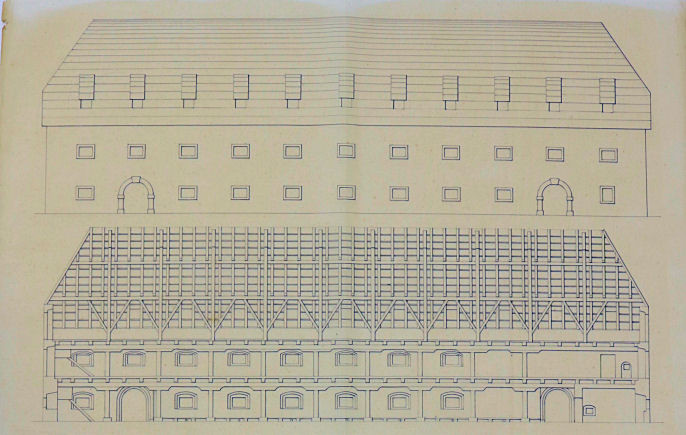Warehouse of Idrija Mercury Mine in Vrhnika

Situation plan. | Author Arhiv Republike Slovenije
Until the completion of the railway to Trieste in the mid-19th century, the transportation of goods had mostly been carried out on the river of Ljubljanica. There was always “abundance of ships” on the river, carrying grain from the Banat region, as well as sugar, Carniolan wood for shipbuilding, wool, tea, scents, spices, salt, and other merchandise. At the river port in Vrhnika the goods were shifted onto heavy carts and transported to Trieste by road. While perishable goods were transported immediately, the rest of the goods were stored in two warehouses located by the Ljubljanica river. One of them was owned by a special toll office, and the other by the Idrija mercury mine.
The grain warehouse for the needs of the Idrija mine was built in the 1760s. Measuring 630 square metres, it was a one-floor building, made of stone with brick roof. Its walls were 80-95 cm thick, it had strong roofing, brick roof, iron window grills, and pillars made of stone and oak running down the middle of it. On the ground floor there were two smaller rooms, an arched kitchen with a chimney, two rooms for tools, one long space for storing grain, and one smaller space for storing ironware. Located on the first floor were a small room, an arched fireplace, and a long spacious room for storing grain. The building of the warehouse was commissioned by the state. It was initially called the Warehouse of Temišvar, but was later renamed into the Warehouse of Idrija. For the purpose of building the warehouse, the state bought a field called Brod from Ludvik Dietrich. On this property, located between Ljubljanska Road and the Ljubljanica river, they built a warehouse with an apartment, a grassland, a garden and a port.
The grain was intended for the Idrija miners, whose wages were paid partly in money and partly in grain. Every four weeks, 575 bushels of wheat were distributed among the miners, along with 247 bushels of rye, 479 bushels of buckwheat, and 213 bushels of millet. Millers, of course, had too much work during that time, so it was decided in 1820 that grain was to be distributed three times a month. To ensure constant supply of grain, the road through Dole to Vrhnika was built in the second half of the 17th century, and a superintendent was employed to supervise the arrival of grain and other necessities in Idrija and the carting away of mercury from Idrija along that route. Until a separate warehouse was built, grain had been stored in Garzarolli’s house and the toll collector Ludvik Dietrich was paid 50 Gulden annually to supervise regular and punctual delivery of grain to Idrija.
However, grain did not always reach its customers. During the French occupation in 1805, the soldiers used up all the grain, as well as removed the wooden equipment from the warehouse and placed 20 cannons inside it. After their departure, the warehouse was once again used for its original purpose.
Once the river traffic on the river of Ljubljanica stopped, the building lost its importance, so the state sold it and its purpose changed several times with each new owner. Today, the mighty building is still standing, its power bearing witness of important things that once took place there.
Presented as this month’s archivalia are two of the interesting plans from the fonds of the Provincial Building Directorate. The Directorate was in charge of the construction and maintenance of roads, bridges, water routes, and provincial buildings in Carniola and for a certain period also in Carinthia. During the operation of the Directorate and its successors, an extensive collection of plans was created in addition to their collection of records. Unfortunately, many of them were drawn on tracing paper, which is a fragile and sensitive material. Deterioration can also be observed in plans on paper.
Olga Pivk

